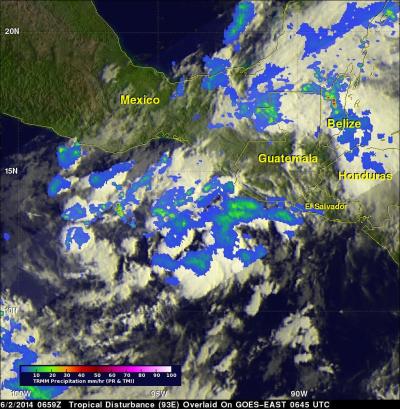NASA's TRMM satellite sees Eastern Pacific tropical cyclone forming

This image of developing tropical low pressure System 93E on June 2 revealed the highest thunderstorms (in red) as it continues to develop. TRMM saw the heaviest rainfall was 115.8 mm (4.6 inches) per hour in another area of disturbed weather over Belize. Credit: SSAI/NASA, Hal Pierce
The eastern Pacific Ocean has become active on cue with the start of the hurricane season in that area. Only a few days after hurricane Amanda weakened and disappeared the National Hurricane Center (NHC) said that development of another tropical cyclone is probable southeast of Salina Cruz, Mexico.
NASA and the Japan Aerospace Exploration Agency's Tropical Rainfall Measuring Mission or TRMM satellite captured rainfall data on System 93E on June 2, 2014 at 0659 UTC (2:59 a.m. EDT).
At NASA's Goddard Space Flight Center in Greenbelt, Maryland, TRMM's Microwave Imager (TMI) and Precipitation Radar (PR) data were overlaid on an enhanced infrared image from NOAA's GOES-EAST satellite received at 0645 UTC (02:45 a.m. EDT) on June 2. TRMM found areas of moderate to heavy rainfall in showers and thunderstorms within the area of this tropical low.
However, the heaviest rainfall found by TRMM in the area covered by this image was 115.8 mm (4.6 inches) per hour in another area of disturbed weather over Belize.
At 2 p.m. EDT, the National Hurricane Center update noted that showers and thunderstorms associated with a low pressure area became better organized during the morning hours. System 93E is located 250 miles south-southeast of Salina Cruz, Mexico,
Because the environmental conditions are conducive for additional development, The National Hurricane Center expects a tropical depression may likely form later today or tonight as the low moves slowly northeastward or northward.
Even though the low has not yet become a depression, the National Hurricane Center reported that it continues to bring very heavy rainfall to portions of western Central America, and is expected to spread over southeastern Mexico during the next couple of days.
These rains could cause life-threatening flash floods and mud slides in areas of mountainous terrain.
As of June 2 at 2 p.m. EDT (11 a.m. EDT), the National Hurricane Center gives System 93E a 90 percent chance of becoming tropical depression 2E in the next 48 hours.
Media Contact
All latest news from the category: Earth Sciences
Earth Sciences (also referred to as Geosciences), which deals with basic issues surrounding our planet, plays a vital role in the area of energy and raw materials supply.
Earth Sciences comprises subjects such as geology, geography, geological informatics, paleontology, mineralogy, petrography, crystallography, geophysics, geodesy, glaciology, cartography, photogrammetry, meteorology and seismology, early-warning systems, earthquake research and polar research.
Newest articles

Bringing bio-inspired robots to life
Nebraska researcher Eric Markvicka gets NSF CAREER Award to pursue manufacture of novel materials for soft robotics and stretchable electronics. Engineers are increasingly eager to develop robots that mimic the…

Bella moths use poison to attract mates
Scientists are closer to finding out how. Pyrrolizidine alkaloids are as bitter and toxic as they are hard to pronounce. They’re produced by several different types of plants and are…

AI tool creates ‘synthetic’ images of cells
…for enhanced microscopy analysis. Observing individual cells through microscopes can reveal a range of important cell biological phenomena that frequently play a role in human diseases, but the process of…





















